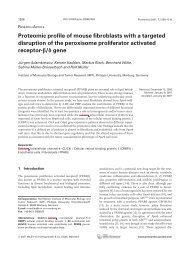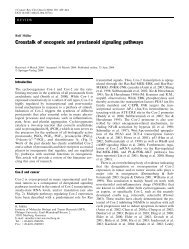Tumor and Inflammation - two Sides of the Coin - IMT
Tumor and Inflammation - two Sides of the Coin - IMT
Tumor and Inflammation - two Sides of the Coin - IMT
Create successful ePaper yourself
Turn your PDF publications into a flip-book with our unique Google optimized e-Paper software.
<strong>Tumor</strong> & <strong>Inflammation</strong><br />
<strong>Tumor</strong> <strong>and</strong> <strong>Inflammation</strong> - <strong>two</strong> <strong>Sides</strong> <strong>of</strong> <strong>the</strong> <strong>Coin</strong><br />
Dr. Abdo Konur<br />
Scientific Coordinator LOEWE Priority Programme<br />
<strong>Tumor</strong> & <strong>Inflammation</strong><br />
January 14, 2011
Cancer, infection <strong>and</strong> inflammation<br />
<strong>Tumor</strong> & <strong>Inflammation</strong><br />
Rudolf Virchow: fa<strong>the</strong>r <strong>of</strong> modern pathology <strong>and</strong> founder<br />
<strong>of</strong> <strong>the</strong> „cellular pathology“ <strong>the</strong>ory<br />
diseases due to defects in individual cells <strong>of</strong> <strong>the</strong> body<br />
all diseases (cancer) start from inflammation<br />
Robert Koch: funding fa<strong>the</strong>r <strong>of</strong> modern bacteriology<br />
all diseases (cancer) start from infections
The seven hallmarks <strong>of</strong> cancer<br />
<strong>Tumor</strong> & <strong>Inflammation</strong><br />
Colotta et al, Carcinogenesis 30:1073 (2009)
Cellular composition <strong>of</strong> tumors<br />
<strong>Tumor</strong> & <strong>Inflammation</strong><br />
<strong>Tumor</strong><br />
non malignant cells<br />
tumor stromal cells<br />
• fibroblasts<br />
• endo<strong>the</strong>lial cells<br />
• blood/lymphatic vessels<br />
• immune-competent cells<br />
macrophages, lymphocytes<br />
malignant cells<br />
The tumor microenvironment
Inflammatory tumor environment<br />
<strong>Tumor</strong> & <strong>Inflammation</strong><br />
extrinsic pathway<br />
driven by inflammatory cells <strong>and</strong> mediators<br />
intrinsic pathways<br />
genetic alterations<br />
mutations in<br />
onco- <strong>and</strong>/or suppressor<br />
genes<br />
inflammation<br />
Cancer<br />
<strong>Inflammation</strong> can cause Cancer<br />
Cancer can cause <strong>Inflammation</strong>
Cancer Development steps<br />
<strong>Tumor</strong> & <strong>Inflammation</strong><br />
‚mutagens‘<br />
‚inflammation‘<br />
‚inflammation‘<br />
Initiation<br />
Promotion<br />
Progression<br />
GENOMIC CHANGES<br />
• point mutations<br />
• gene deletion <strong>and</strong> amplification<br />
• chromosomal rearrangements<br />
SURVIVAL <strong>and</strong> CLONAL<br />
EXPANSION <strong>of</strong> „initiated cells“<br />
SUBSTANTIAL GROWTH in<br />
tumor size <strong>and</strong> METASTASIS
Role for inflammation in Cancer<br />
<strong>Tumor</strong> & <strong>Inflammation</strong><br />
approx. only 5 – 10% <strong>of</strong> all cancer cases<br />
can be attributed to genetic defects,<br />
<strong>the</strong> remaining 90 - 95% have <strong>the</strong>ir roots in<br />
<strong>the</strong> environment <strong>and</strong> lifestyle<br />
approx. 20% <strong>of</strong> all malignancies are initiated<br />
or exacerbated by inflammation
Role for inflammation in Cancer<br />
<strong>Tumor</strong> & <strong>Inflammation</strong><br />
Cancer risk factors<br />
- environmental <strong>and</strong> lifestyle -<br />
chronic <strong>Inflammation</strong><br />
physical inactivity<br />
high calorie diet<br />
obesity<br />
chronic infection<br />
alcohol<br />
activation <strong>of</strong>: NFκB, AP-1, STAT3<br />
tobacco<br />
radiation<br />
sun exposure<br />
environmental pollutants
Chronic <strong>Inflammation</strong>:<br />
predisposition for tumor development<br />
<strong>Tumor</strong> & <strong>Inflammation</strong><br />
Clinical Evidence (some examples)<br />
Disease associated tumors Etiology<br />
Colitis ulcerosa, M. Crohn Colon-Ca. Autoimmune Disease<br />
Chronic Gastritis Gastric-Ca., MALT Helicobacter pylori<br />
gastroesophageal reflux<br />
Disease<br />
Esophagus-Ca.<br />
Gastric acid<br />
Hepatitis Hepatocellular Ca. Hepatitis B und C virus<br />
Chronic Pancreatitis Pancreas-Ca. Alcoholism<br />
Asbestosis Meso<strong>the</strong>liom, Lung-Ca. Asbestos<br />
COPD Lung-Ca. tobacco<br />
Schistosomiasis Bladder- <strong>and</strong> Liver-Ca. Vermin
Gastric Carcinoma<br />
<strong>Tumor</strong> & <strong>Inflammation</strong>
Stomach ulcer <strong>and</strong> stress<br />
<strong>Tumor</strong> & <strong>Inflammation</strong><br />
Twenty years ago we thought <strong>of</strong> stomach ulcers as a stress related disease<br />
Top 10 most stressful jobs<br />
Inner City HS Teacher<br />
Police Officer<br />
Miner<br />
Air traffic controller<br />
Medical intern<br />
Stockbrocker<br />
Journalist<br />
Customer Service<br />
Secretary<br />
Waiter<br />
Top 10 least stressful jobs<br />
Forester<br />
Bookbinder<br />
Telephone line worker<br />
Toolmaker<br />
Millwright<br />
Repairperson<br />
Civil engineer<br />
Therapist<br />
Natural Scientist<br />
Sales Representative<br />
according to Health Magazine
Treatment <strong>of</strong> ulcers with antacids...<br />
<strong>Tumor</strong> & <strong>Inflammation</strong>
... <strong>and</strong> by reducing stress<br />
<strong>Tumor</strong> & <strong>Inflammation</strong>
Helicobacter pylori (H.p.) induced<br />
gastric cancer <strong>and</strong> MALT lymphoma<br />
<strong>Tumor</strong> & <strong>Inflammation</strong><br />
... but The not Nobel everybody Prize in thought Physiology that ulcers or Medicine were stress 2005 related<br />
but induced by bacteria (1983)<br />
was awarded jointly to<br />
Barry Marshall <strong>and</strong><br />
J. Robin Warren<br />
Barry J. Marshall<br />
"for <strong>the</strong>ir discovery <strong>of</strong> <strong>the</strong> bacterium<br />
Helicobacter pylori <strong>and</strong> its role in<br />
gastritis <strong>and</strong> peptic ulcer disease“<br />
J. Robin Warren
Mode <strong>of</strong> action <strong>of</strong> H.p.<br />
<strong>Tumor</strong> & <strong>Inflammation</strong><br />
• H.p. helix-shaped, gram-negative, microaerophilic bacterium<br />
• highly motile due to 4-6 flagella<br />
• H.p. colonize <strong>the</strong> stomach, burrows into <strong>the</strong> mucus<br />
• neutralization <strong>of</strong> <strong>the</strong> gastric acid by urease<br />
H. pylori : Electron-microscopical photo<br />
Philip Sutton, Immunology <strong>and</strong> Cell Biology 2001
Epidemiology <strong>of</strong> H. pylori<br />
<strong>Tumor</strong> & <strong>Inflammation</strong><br />
• Half <strong>of</strong> <strong>the</strong> world‘s population are infected by H.p.<br />
(Third world approx. 80%, Western countries around 25%)<br />
• Asymptomatic colonization 80%<br />
but always detectabel gastritis histologically<br />
• approx. 20% will develop gastric <strong>and</strong> duodenal ulcer<br />
• 1 – 2% lifetime risk <strong>of</strong> stomach cancer <strong>and</strong> approx. 1% risk for gastric<br />
MALT lymphoma<br />
<strong>the</strong> risk <strong>of</strong> getting gastric cancer from H.p. is as high as getting lung<br />
cancer from smoking<br />
H.p. is detectable in 95% (!) <strong>of</strong> all MALT lymphoma <strong>and</strong><br />
H.p. eradication with antibiotics induces regression <strong>of</strong> lowgrade<br />
MALT lymphomas<br />
H.p. has been classified as a CARCINOGEN by <strong>the</strong> WHO
Chronic inflammatory states<br />
associated with H.p. infection<br />
<strong>Tumor</strong> & <strong>Inflammation</strong><br />
urea<br />
+ H2O<br />
urease<br />
CO2<br />
+ NH3<br />
Acidic Gastric Juice<br />
Mucus gel layer<br />
gastric epi<strong>the</strong>lial cells<br />
pH=2<br />
pH=4<br />
pH=7<br />
protected space<br />
attracting <strong>and</strong> activation<br />
<strong>of</strong> immune cells<br />
chronic inflammation
<strong>Tumor</strong> & <strong>Inflammation</strong><br />
How does H.p. damage stomach tissue<br />
50 – 70% <strong>of</strong> H.p. express <strong>the</strong><br />
CagA pathogenecity isl<strong>and</strong><br />
direct effects<br />
indirect effects<br />
Gastric epi<strong>the</strong>lial<br />
cell damage by:<br />
• proteases<br />
• phospholipases<br />
• ammonia (NH 3 )<br />
• toxins (VacA)<br />
induction <strong>of</strong> an inflammatory<br />
response by H.p.<br />
• bacterial peptidoglycan <strong>and</strong> CagA protein<br />
is injected into <strong>the</strong> epi<strong>the</strong>lial cells<br />
inflammatory cytokine release, recruitment <strong>of</strong><br />
inflammatory cells (granulocytes, macrophages);<br />
activation <strong>of</strong> EGFR (altered signal transcription)
Induction <strong>of</strong> a chronic inflammatory<br />
response by H.p. CagA protein<br />
<strong>Tumor</strong> & <strong>Inflammation</strong><br />
The Cag pathogenicity isl<strong>and</strong> encodes a secretory system<br />
p50 p65 activation <strong>of</strong> inflammatory genes
Host cell Transcriptional<br />
Response to H.p. CagA<br />
<strong>Tumor</strong> & <strong>Inflammation</strong><br />
Reference RNA<br />
from uninfected<br />
gastric epi<strong>the</strong>lial<br />
cells<br />
RNA from H.p.<br />
infected gastric<br />
epi<strong>the</strong>lial cells<br />
Which genes are differently regulated<br />
between H.p. treated <strong>and</strong> untreated<br />
epi<strong>the</strong>lial cells<br />
RNA downregulated in infected cells<br />
RNA unchanged in infected cells<br />
RNA upregulated in infected cells
Specific expression pr<strong>of</strong>ile <strong>of</strong> epi<strong>the</strong>lial cells<br />
<strong>of</strong> <strong>the</strong> stomach upon H.p. infection<br />
<strong>Tumor</strong> & <strong>Inflammation</strong><br />
The <strong>two</strong> most abundant functional classes <strong>of</strong><br />
induced genes encoded proteins involved in<br />
<strong>the</strong>:<br />
Innate Immun response (cytokines,<br />
chemokines)<br />
Regulation <strong>of</strong> cell shape <strong>and</strong> adhesion<br />
(ICAM1, tight junction proteins; claudin)<br />
Guillemin et al (2002) PNAS USA 99(23): 15136–15141.
Colon Carcinoma<br />
<strong>Tumor</strong> & <strong>Inflammation</strong>
Colitis associated Colorectal cancer<br />
<strong>Tumor</strong> & <strong>Inflammation</strong><br />
• a chronic (auto-) inflammatory bowel disease<br />
• have a 1 % increased risk to develop cancer for every<br />
year <strong>of</strong> disease; that means that patients suffering from<br />
colitis for 30 years have a 30% increased risk to<br />
develop colorectal cancer<br />
• activation <strong>of</strong> NFκB plays a dominant role in this cancer
Colitis associated cancer (CAC) mouse model<br />
<strong>Tumor</strong> & <strong>Inflammation</strong><br />
1. induce mutations<br />
2. induce inflammation<br />
apply a carcinogen (e.g. azoxymethane; AOM)<br />
intraperitoneally<br />
mice are feed with dextran sulfate sodium (DSS)<br />
which is a toxin for colonic epi<strong>the</strong>lial cells,<br />
<strong>the</strong>reby inducing leukocyte infiltration<br />
1 + 2 = <strong>Tumor</strong>
NFκB: a central transcription factor I<br />
<strong>Tumor</strong> & <strong>Inflammation</strong><br />
Signal<br />
p50<br />
Inflammatory cell<br />
p65<br />
- normal cells -<br />
gene<br />
expression<br />
Cancer cell<br />
p50<br />
gene<br />
expression<br />
p65<br />
Help for <strong>the</strong><br />
tumor cells<br />
to survive<br />
Survival
NFκB: a central transcription factor II<br />
<strong>Tumor</strong> & <strong>Inflammation</strong><br />
Inflammatory cytokines<br />
TNFα, IL1, IL-6 etc.<br />
Bacterial constituents<br />
LPS, LTA, dsRNA, CpG-DNA<br />
+<br />
+<br />
NFκB<br />
<strong>Inflammation</strong><br />
(iNOS, Cox2, PLA2,<br />
TNFα, IL-1, etc.)<br />
Innate Immunity<br />
(Defensins, Chemokines,<br />
Cytokines, Adhesion<br />
molecules)<br />
Anti-Apoptosis<br />
(cIAP1/2, A1, Bcl-X L , cFLIP)
NFκB: a central transcription factor III<br />
<strong>Tumor</strong> & <strong>Inflammation</strong><br />
IKKβ<br />
pharmacological<br />
inhibitors<br />
NFκB (p50/p65)<br />
Anti-apoptosis<br />
Innate Immunity,<br />
<strong>Inflammation</strong>
NFκB as a taget for Colon cancer <strong>the</strong>rapy<br />
<strong>Tumor</strong> & <strong>Inflammation</strong><br />
Growth &<br />
Survival factors<br />
<strong>Tumor</strong><br />
progression<br />
p50<br />
Inflammatory cell<br />
- normal cells -<br />
X<br />
p65<br />
TNFα<br />
IL-1<br />
IL-6<br />
Cancer cell<br />
Activation<br />
p50<br />
X<br />
p65<br />
Survival<br />
Bcl-x L<br />
GADD 45<br />
NOD-2<br />
<strong>Tumor</strong>-derived factors which<br />
reprogramme inflammatory<br />
cells to promote tumor survival
<strong>Tumor</strong> & <strong>Inflammation</strong><br />
Colon carcinoma<br />
Colon<br />
X<br />
NFκB<br />
increase <strong>of</strong> apoptosis<br />
<strong>the</strong>reby<br />
inhibition <strong>of</strong> tumor cell growth
Hepatocellular Carcinoma<br />
<strong>Tumor</strong> & <strong>Inflammation</strong>
Role for Compensatory Proliferation<br />
in Hepatocellular Carcinoma<br />
<strong>Tumor</strong> & <strong>Inflammation</strong><br />
Hepatocytes<br />
KC (10% <strong>of</strong> <strong>the</strong> liver)<br />
TUMOR<br />
INITIATION<br />
+ mutagens<br />
Mutation<br />
liver injury<br />
IL-6<br />
IL-6<br />
IL-6<br />
Dead cells<br />
TUMOR<br />
PROMOTION
Role for NFκB in different tumor models<br />
<strong>Tumor</strong> & <strong>Inflammation</strong><br />
Colon<br />
X<br />
NFκB<br />
inhibition <strong>of</strong> proliferation<br />
in malignant cells<br />
let <strong>the</strong>m die<br />
increase <strong>of</strong> apoptosis<br />
<strong>the</strong>reby<br />
inhibiting <strong>of</strong> tumor cell growth<br />
Colon<br />
carcinoma<br />
Hepatocytes<br />
X<br />
NFκB<br />
induction <strong>of</strong> proliferation<br />
in initiated cells<br />
generate space for cell<br />
proliferation<br />
increase <strong>of</strong> apoptosis<br />
but<br />
support <strong>of</strong> tumor cell growth<br />
Hepatocellular<br />
carcinoma<br />
Macrophages<br />
X<br />
NFκB<br />
inhibition <strong>of</strong> tumor<br />
supportive actions<br />
turn <strong>of</strong>f help<br />
inhibition <strong>of</strong> tumor cell growth<br />
in both tumor<br />
models<br />
Maeda...Karin Cell 121:977 (2005).<br />
Karin & Greten Nat Rev Immunol 5:749 (2005).
Take home message<br />
<strong>Tumor</strong> & <strong>Inflammation</strong><br />
<strong>Inflammation</strong><br />
Innate Immune cells<br />
OFF
<strong>Tumor</strong> & <strong>Inflammation</strong><br />
Philipp<br />
Holz<br />
Philipp<br />
Bergmaier<br />
Sukyung<br />
Choi<br />
Haicui<br />
Wang


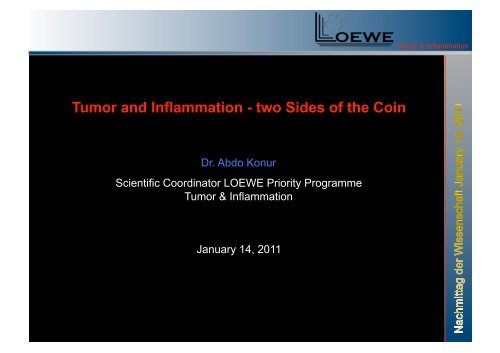
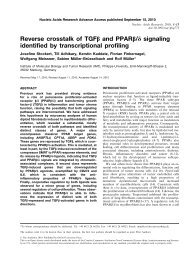


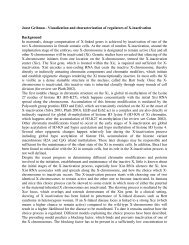
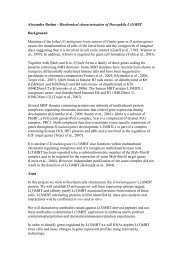
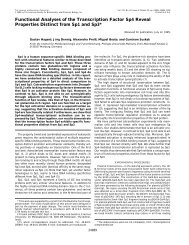
![2-(2-Bromophenyl)-3-{[4-(1-methyl-piperazine)amino]phenyl}](https://img.yumpu.com/22645635/1/190x248/2-2-bromophenyl-3-4-1-methyl-piperazineaminophenyl.jpg?quality=85)
